#MIT Technology Review Massachusetts Institute of Technology
Explore tagged Tumblr posts
Text
The Boston Globe's view of the response at MIT to the decision by the lay members of the Cambridge Experimentation Review Board to allow recombinant DNA experiments to continue in the city.

"Frankenstein's Footsteps: Science, Genetics and Popular Culture" - Jon Turney
#book quotes#frankenstein's footsteps#jon turney#nonfiction#boston globe#mit#massachusetts institute of technology#cambridge experimentation review board#recombinant dna#science experiments#liquid nitrogen#genetic research#political cartoon
1 note
·
View note
Text
According to a new study, adults who received the Pfizer Comirnaty COVID-19 shot were more likely to die than adults who had the Moderna Spikevax COVID-19 shot. The study looked at 9.2 million adults living in Florida who received either Comirnaty or Spikevax within six weeks, from December 2020 through January 20221. Half of the nearly 1.5 million participants received the Pfizer shot and the other half had the Moderna shot. Participants were matched based on age and gender.1
The study, “Twelve-Month All-Cause Mortality after Initial COVID-19 Vaccination with Pfizer-BioNTech or mRNA-1273 among Adults Living in Florida” was conducted by Florida Surgeon General, Joseph Ladapo, MD, and Retsef Levi, PhD of the Massachusetts Institute of Technology (MIT), as well as two other researchers. The study is in preprint and has not yet been peer-reviewed.2
Pfizer Shot Causes Significantly Higher All-Cause Death
Participants were compared 12 months after their first dose of the COVID shots. Researchers looked at all-cause mortality, cardiovascular mortality, and COVID mortality, together with non-COVID causes of death which occurred within 12 months after participants received a shot.
In terms of all-cause mortality, participants who received the Pfizer shot had a 37 percent higher risk than Moderna shot recipients. The risk for those who received the Pfizer shot was 847.2 and 617.9 for Moderna shot recipients per 100,000 people. Therefore, there were 229.2 excess deaths per 100,000 people in the Pfizer group than in the Moderna group.3
In terms of death due to cardiovascular events, the risk for those who took the Pfizer shot increases to 53 percent. There were 248.7 cardiovascular deaths in the Pfizer group and 162.4 deaths in the Moderna group with a difference of 86.3 extra deaths per 100,000 people in the Pfizer group.4
9 notes
·
View notes
Text
by Dion J. Pierre
The author, PhD candidate Prahlad Iyengar, continued, “One year into a horrific genocide, it is time for the movement to begin wreaking havoc, or else, as we’ve seen, business will indeed go on as usual … As people of conscience in the world, we have a duty to Palestine and to all the globally oppressed. We have a mandate to exact a cost from the institutions that have contributed to the growth and proliferation of colonialism, racism, and all oppressive systems. We have a duty to escalate for Palestine, and as I hope I’ve argued, the traditional pacifist strategies aren’t working because they are ‘designed into’ the system we fight against.”
In a statement distributed by the CAA, Iyengar accused MIT of weaponizing the disciplinary system to persecute him.
“On Friday, MIT administration informed me that as a result of this article, I have been banned from campus without due process and that I face potential expulsion or suspension,” he said. “These extraordinary actions should concern everyone on campus. My article attempts a historical review of the type of tactics used by protest movements throughout history, from the civil rights movement to the struggle to the fight [sic] against South African Apartheid here on MIT campus.”
MIT has not responded to The Algemeiner‘s inquiry regarding Iyengar’s punishment, but according to excerpts of its letter to Iyengar, the administration told him the article “makes several troubling statements” and could be perceived as “a call for more violent or destructive forms of protest at MIT.” In retaliation, CAA is calling on students to harass David Randall, an associate dean, until he relents and revokes Iyengar’s punishment and Written Revolution‘s temporary suspension.
“On Pacifism” is not the first time that elite college students have endorsed violence in the name of opposing Israel and furthering the Palestinian cause.
In September, during Columbia University’s convocation ceremony, Columbia University Apartheid Divest (CUAD), a group which recently split due to racial tensions between Arabs and non-Arabs, distributed literature calling on students to join the Palestinian terrorist group Hamas’s movement to destroy Israel.
“This booklet is part of a coordinated and intentional effort to uphold the principles of the thawabit and the Palestinian resistance movement overall by transmitting the words of the resistance directly,” said the pamphlet distributed by CUAD, a Students for Justice in Palestine (SJP) spinoff, to incoming freshmen. “This material aims to build popular support for the Palestinian war of national liberation, a war which is waged through armed struggle.”
Other sections of the pamphlet were explicitly Islamist, invoking the name of “Allah, the most gracious” and referring to Hamas as the “Islamic Resistance Movement.” Proclaiming, “Glory to Gaza that gave hope to the oppressed, that humiliated the ‘invincible’ Zionist army,” it said its purpose was to build an army of Muslims worldwide.
17 notes
·
View notes
Text
by Alec Schemmel
Last fall, Massachusetts Institute of Technology president Sally Kornbluth tapped a group of Jewish faculty members to advise the school on a new initiative meant to combat campus anti-Semitism. The participants were "hopeful," they said in an email to fellow MIT staff, that the move would help them "more effectively influence the decision making to reduce the tensions on campus."
Shortly thereafter, in January, an announcement from MIT chancellor Melissa Nobles dashed those hopes.
The school's "Standing Together Against Hate" (STAH) initiative, Nobles said, would include four panels: one on anti-Semitism, one on "campus freedom of expression," one on Islamophobia, and one on "anti-Palestinian racism." Omitted from the speaker series was any talk on racism or hatred targeting Israelis and Zionists.
MIT's hand-picked speakers also prompted concern. Islamophobia panelist Dalia Mogahed in the wake of Oct. 7 endorsed Hamas terrorism as an act of lawful "resistance" and suggested that Israelis are "savages" who "kill babies" and "bomb hospitals." Free speech panelist Erwin Chemerinsky, meanwhile, serves as the dean of the University of California, Berkeley, School of Law, which was sued in November over "unchecked" campus anti-Semitism.
For the Jewish faculty members, Nobles's announcement came as a surprise—not because MIT declined to take their advice on panel topics and speakers, but because the school failed to seek out their advice altogether. The members responded by disbanding their advisory group.
"As our group was originally conceived in the framework of STAH, we want to emphasize that we had no input to the published program and/or reviewed it before its announcement," the advisory group members said in their February email. "As a result, we recently informed President Kornbluth that we would disband the advisory group."
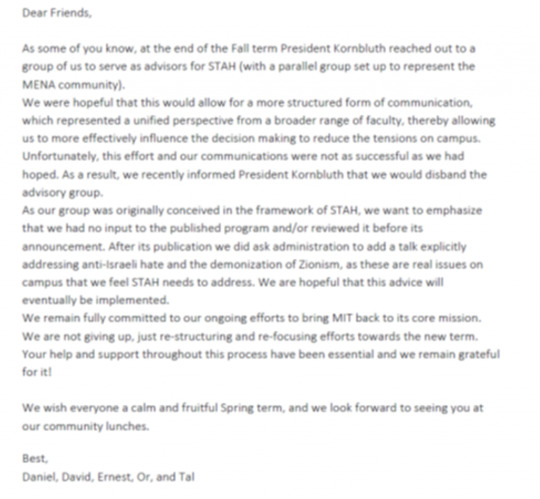
Kornbluth has since vowed to reassess MIT's policies on "harassment, bullying, intimidation and discrimination." She also launched the "Standing Together Against Hate" initiative in November, which MIT leaders said would help "bring our community together" by addressing anti-Semitism and other "tension between some groups and individuals."
Instead, the initiative created tension between Kornbluth and Jewish faculty members, calling into question the embattled president's pledge to combat anti-Semitism. For the MIT Israel Alliance, a campus group formed in the wake of Oct. 7 to protect Jewish students, Kornbluth's freezing out of the advisory committee marks a "missed opportunity … to tackle the very real and disturbing heightened antisemitism on campus."
24 notes
·
View notes
Text
Stati quantistici complessi visti al microscopio

Prime immagini di singoli atomi in libertà, grazie alla microscopia con risoluzione atomica. Nei laboratori del Massachusetts Institute of Technology sono state catturate per la prima volta immagini di singoli atomi che interagiscono liberamente nello spazio. Queste immagini mostrano correlazioni tra particelle libere, previste dalla teoria ma mai osservate direttamente, offrendo una nuova finestra sui fenomeni quantistici. I fisici del Massachusetts Institute of Technology (Mit) hanno catturato per la prima volta immagini di singoli atomi che interagiscono liberamente nello spazio. Queste immagini mostrano correlazioni tra particelle libere, previste dalla teoria ma mai osservate direttamente, offrendo una nuova finestra sui fenomeni quantistici.

Utilizzando la microscopia con risoluzione a singolo atomo, i gas quantistici ultrafreddi composti da due tipi di atomi mostrano correlazioni spaziali nettamente diverse: i bosoni a sinistra mostrano un raggruppamento, mentre i fermioni a destra presentano un comportamento di anti-raggruppamento. Crediti: Sampson Wilcox Il risultato, pubblicato su Physical Review Letters, è stato possibile grazie all’impiego di una tecnica innovativa – sviluppata dai ricercatori stessi – nella quale una nuvola di atomi viene lasciata libera di muoversi, poi congelata per un istante grazie a un reticolo di luce. Un laser illumina gli atomi sospesi, rivelandone la posizione precisa. Questo approccio, noto come microscopia con risoluzione atomica, consente di visualizzare singoli atomi e le loro interazioni. Un atomo misura circa un decimo di nanometro, ossia è un milione di volte più piccolo dello spessore di un capello, ed è governato dalle leggi della meccanica quantistica, che ne rendono difficile la localizzazione esatta. Le tecniche convenzionali mostrano l’intera nuvola di atomi, ma non i singoli componenti. Come spiega il fisico Martin Zwierlein, «è come vedere una nuvola nel cielo, ma non le singole gocce». Usando questa tecnica, i ricercatori hanno osservato direttamente bosoni e fermioni mentre interagivano nello spazio libero, un passo cruciale per comprendere fenomeni come la superconduttività. In particolare, Zwierlein e colleghi hanno fotografato per la prima volta una nube di bosoni composta da atomi di sodio. A basse temperature, una nube di bosoni forma il cosiddetto condensato di Bose-Einstein, uno stato della materia in cui tutti i bosoni condividono lo stesso stato quantico. Ketterle del Mit è stato uno dei primi a produrre un condensato di Bose-Einstein, di atomi di sodio, per il quale ha vinto il premio Nobel per la fisica nel 2001. Il gruppo di Zwierlein è riuscito a “fotografare” i singoli atomi di sodio all’interno della nube e a osservare le loro interazioni quantistiche. Da tempo si prevede che i bosoni si “raggruppino” tra loro, avendo una maggiore probabilità di trovarsi l’uno vicino all’altro. Questo raggruppamento è una conseguenza diretta della loro capacità di condividere la stessa onda di de Broglie. Tale carattere ondulatorio è stato previsto per la prima volta dal fisico Louis de Broglie, che in parte ha dato il via alla meccanica quantistica moderna. Il team ha anche fotografato una nuvola composta da due diversi tipi di atomi di litio. Ciascun tipo è un fermione, e come tali, i fermioni tendono naturalmente a respingersi. Tuttavia, alcuni fermioni possono interagire fortemente con altri di tipo diverso. Durante l’acquisizione delle immagini, i ricercatori hanno osservato che i due tipi di fermioni interagivano tra loro e formavano coppie, un meccanismo noto da tempo in teoria, ma mai osservato direttamente fino a ora. Secondo i ricercatori, queste immagini rendono visibili concetti finora solo teorici. In futuro, la tecnica potrebbe permettere di esplorare stati quantistici ancora più complessi, come quelli dell’effetto Hall quantistico, tuttora poco compresi. Per saperne di più: Leggi su Physical Review Letters l’articolo “Measuring Pair Correlations in Bose and Fermi Gases via Atom-Resolved Microscopy” di Ruixiao Yao, Sungjae Chi, Mingxuan Wang, Richard J. Fletcher e Martin Zwierlein Read the full article
2 notes
·
View notes
Text
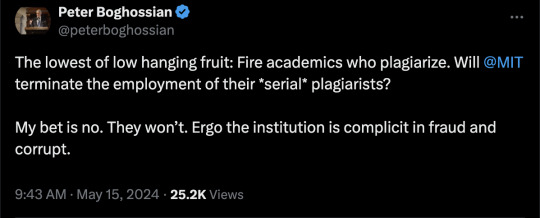
By: Aaron Sibarium
Published: May 14, 2024
In dissertation titled 'Cite a Sista,' Tracie Jones-Barrett stole an entire passage on 'ethical considerations' from her classmate
In June 2021, a year into the cultural aftershocks of George Floyd's death, the Massachusetts Institute of Technology set out to meet the moment, as so many other schools had, by hiring more diversity officers.
MIT welcomed six new deans of diversity, equity, and inclusion, one for each of the institute's main schools, as part of a "DEI Strategic Action Plan" launched the previous year. Aimed at boosting the representation of women and minorities, in part by developing DEI criteria for staff performance reviews, the plan pledged to "make equity central" to the university "while ensuring the highest standards of excellence."
But according to a 71-page complaint filed with the university on Saturday, at least two of the six DEI officials may not be living up to those standards. The complaint alleges that Tracie Jones-Barrett and Alana Anderson are serial plagiarists, copying entire pages of text without attribution and riding roughshod over MIT's academic integrity policies.
In her 2023 dissertation titled "Cite a Sista," which explored how black women in the Ivy League "make meaning of thriving," Jones-Barrett, MIT’s deputy "equity officer," lifts a whole section on "ethical considerations" from Emmitt Wyche III, her classmate in Northeastern University's Graduate School of Education, without any sort of citation.
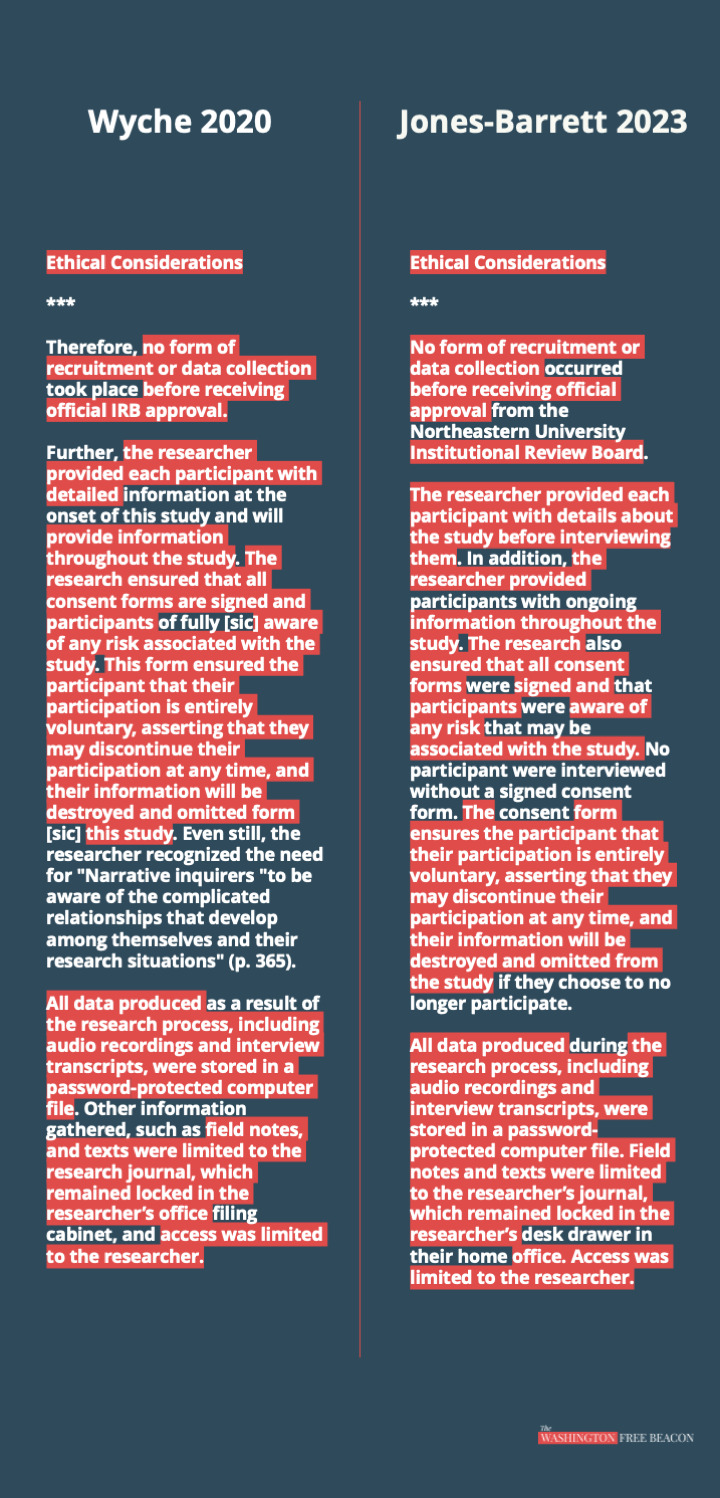
The section is one of several long passages taken from Wyche's 2020 thesis, "Boyz in the Hoods: (Re) Defining the Narratives of Black Male Doctoral Degree Completers," which does not appear in Jones-Barrett's bibliography. Wyche and Jones-Barrett did not respond to requests for comment.
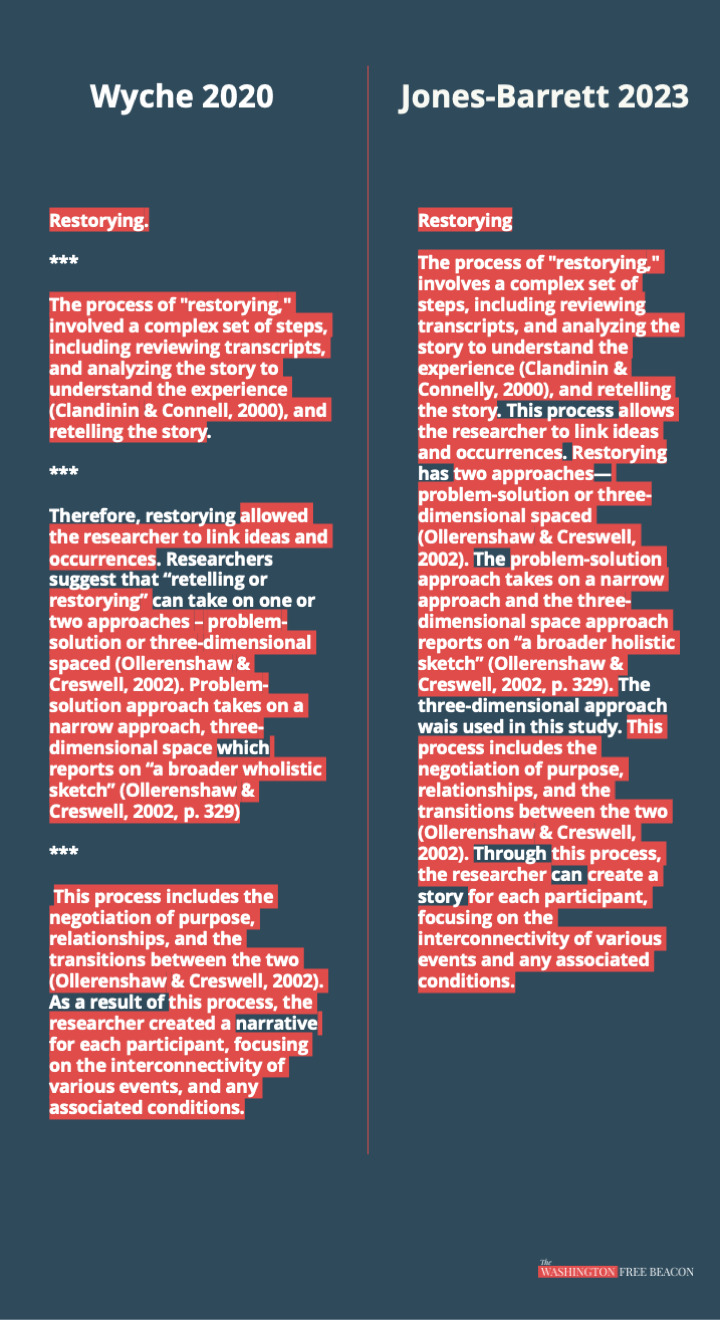
Anderson, who served as the diversity czar for MIT's computer science college until last year, when she left to become Boston Beer Company's inclusion and belonging program manager, likewise copied copious material from other scholars. Her 2017 dissertation, "#BLACKONCAMPUS: A Critical Examination of Racial and Gender Performances of Black College Women on Social Media," lifts over a page of material from Mark Chae, a professor of counseling at Pillar College, who is not cited anywhere in her dissertation.

"It would have been nice to at least get a citation!" Chae told the Washington Free Beacon in an email. "Anderson seems quite comfortable in taking credit for large portions of another writer's scholarly work."
Anderson, who held DEI posts at Boston University and Babson College before coming to MIT, lifts another long passage from Jarvis Givens, a professor at the Harvard Graduate School of Education, without an in-text citation. The omissions appear to violate MIT's plagiarism policy, which states that scholars must cite their sources any time they "use the words, ideas, or phrasing of another person."

MIT did not respond to multiple requests for comment.
In total, the two diversity deans lifted about 10 full pages of material without attribution, according to the complaint, as well as dozens of shorter passages sprinkled throughout their theses.
Like former Harvard University president Claudine Gay, who resigned in January amid her own plagiarism scandal, Anderson even stole language from another scholar's acknowledgments, copying phrases and sentences used by Khalilah Shabazz, now a diversity official at Indiana University-Purdue University Indianapolis, to thank her dissertation advisers.
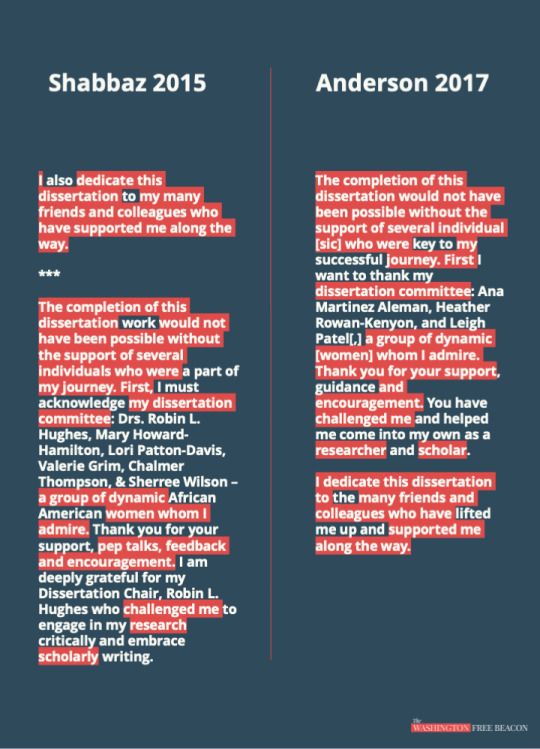
Anderson's acknowledgments contain several typos not seen in Shabbaz's, including missing words and commas and a lack of subject-verb agreement.
Givens and Shabbaz did not respond to requests for comment. Anderson, who received her Ph.D. from Boston College's school of education, did not respond to a request for comment. Boston Beer Company did not respond to a request for comment.
Saturday's complaint, which was submitted to Boston College and Northeastern University alongside MIT, is the latest in a string of plagiarism allegations against campus diversity officials. Since Gay's resignation, DEI officers at Harvard, Columbia, the University of Wisconsin-Madison, and the University of California, Los Angeles, have been accused of research misconduct. Some, such as Columbia medical school's Alade McKen and UCLA medical school's Natalie Perry, copied pages of material from various sources—including Wikipedia—while others passed off old studies as new work.
The accused administrators have not been publicly sanctioned by their universities, which have either declined to comment on the allegations or issued statements in support of the officials. The complaint against Anderson and Jones-Barrett may be harder for MIT to brush aside, however, given the school's high-profile efforts to distance itself from DEI in the post-October 7 era.
The institute said this month that it would no longer require diversity statements from candidates applying to faculty positions, making it the first elite university to jettison the practice. It also led the way in restoring SAT requirements after many colleges went test-optional in an effort to boost diversity.
The pushback has come largely from MIT faculty and been driven, in part, by a sense that DEI programs excuse and even encourage anti-Semitism. An April article in MIT's faculty newsletter noted that an event on "Jewish inclusion" had whitewashed the rhetoric of the school's pro-Palestinian protesters, who have occupied campus buildings, called for "Intifada revolution," and allegedly chanted "death to Zionists."
"Jewish students," a blurb for the DEI event read, "are encountering much of the same discomfort that other minorities face on campus and in the world, in that they don't feel heard or acknowledged."
The two dissertations at issue are strikingly derivative, cobbled together from classmates, online sources, and even a book's dust jacket, and at times read like replicas of their unattributed source material.
Jones-Barrett's summary of her dissertation, for example, is nearly identical to the summary Wyche provides of his own. Both papers use "semi-structured interviews" to "gather insights" from black graduates of Ph.D. programs about their "subjective experiences" of "meaning-making," or, as Wyche misspells it, "mean-making." The primary difference is that Wyche's study deals with black men, while Jones-Barrett's deals with black women.
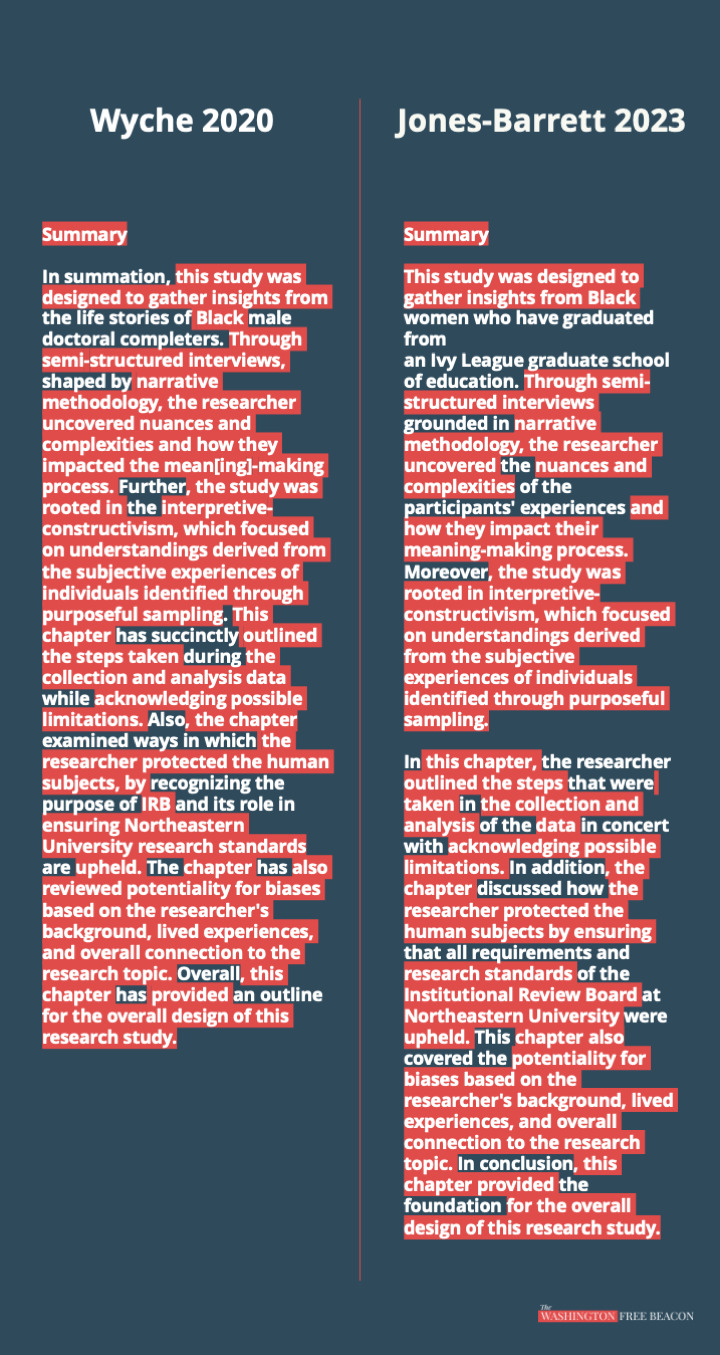
"This study, the first of its kind[,] uses Black Feminist Thought as a framework to explore and investigate how Black women at Ivy League graduate schools of education make meaning of thriving," reads the first sentence of Jones-Barrett's dissertation, which is missing a comma. "There are limited studies that center the voices of Black women at Ivy League graduate schools and there are no studies that look specifically at Ivy League graduate schools of education."
Jones-Barrett, who has taught courses at Harvard Extension School and was initially hired as the assistant dean of diversity, equity, and inclusion for MIT's humanities school, also poached a passage on "potential research bias" from Wyche—now a DEI consultant who describes himself on LinkedIn as a "status quo disrupter"—which asserts that "it is nearly impossible for the researcher to isolate their experiences from the investigative process."

He's not the only classmate Jones-Barrett appears to have plagiarized: On the first page of her dissertation, she lifts an entire paragraph from Scott Fitzsimmons, who earned his Ph.D. in education from Northeastern in 2021, without attribution, swapping out "rural EMS leaders" for "Black women in graduate programs." Fitzsimmons declined to comment.
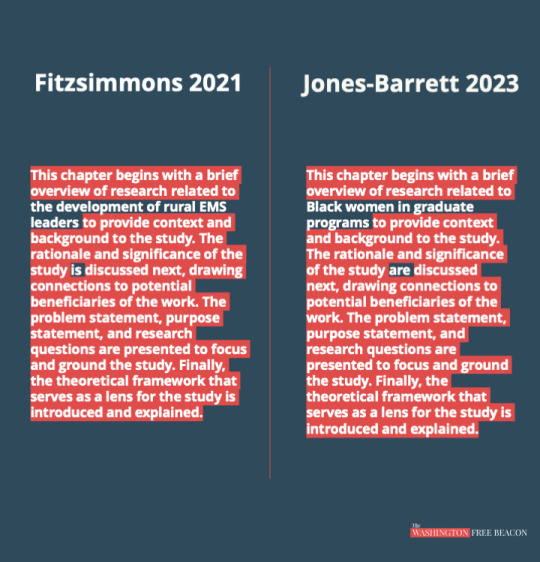
Anderson, meanwhile, lifts several paragraphs from a 2016 ThinkProgress article about her alma mater, Boston College, from which some of her study's interview subjects were drawn. That plagiarism undercuts her effort to prevent the school, to which she refers with a pseudonym, from being identified—a possible violation of the study's consent form, which promised participants that no "identifying information" would be disclosed.
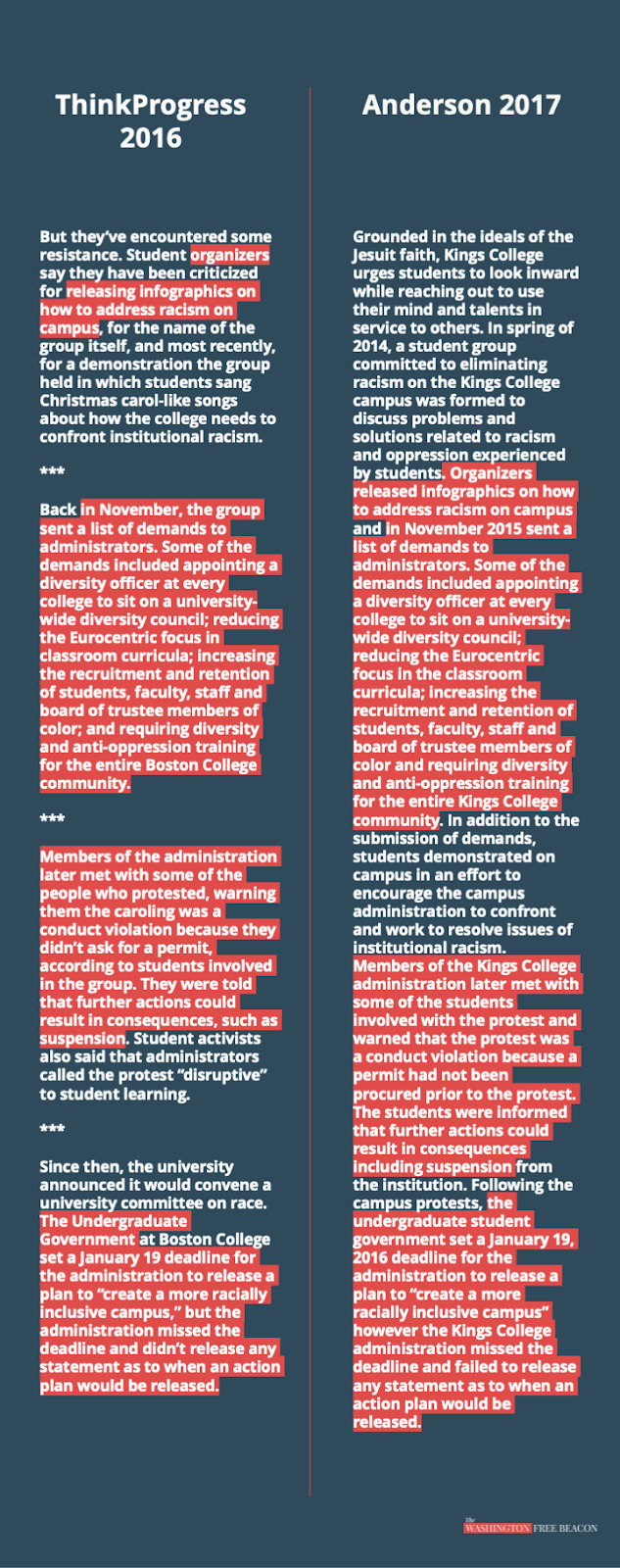
Boston College and Northeastern University did not to requests for comment.
Anderson—who runs her own consultancy that offers "scientifically-based" DEI programming—also borrows three sentences from the dust jacket of Ebony and Ivy, a 2013 book by MIT historian Craig Wilder, who is only cited in one of the sentences and whose words do not appear in quotation marks.
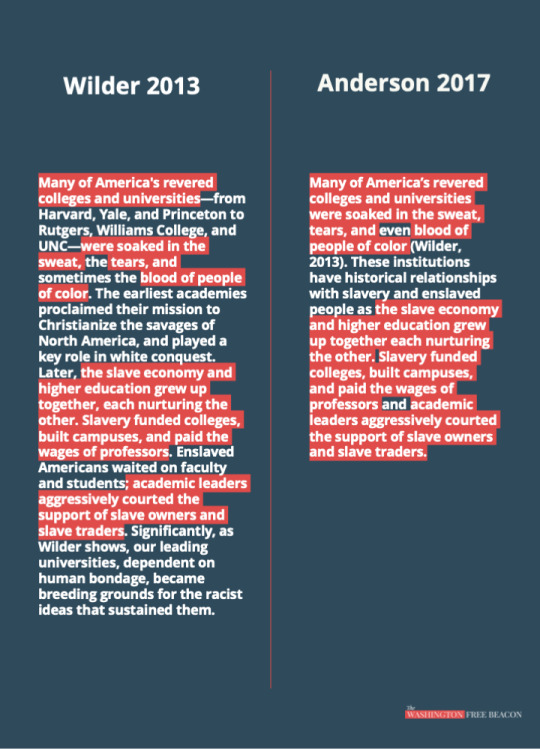
Like many of the authors plagiarized by Gay, Wilder defended Anderson's decision to copy his work, writing in an email that he didn't think a citation was necessary.
"I cannot imagine why anyone would cite a dust jacket, nor do I see the urgency of criminalizing the failure to do so," Wilder told the Free Beacon. "I'm honored," he added, when other scholars "find inspiration from my publications."
==
It's safest to assume all DEI apparatchiks and commissars are plagiarists, frauds and liars until proven otherwise.
#Aaron Sibarium#plagiarism#academic corruption#academic fraud#Alana Anderson#serial plagiarism#Tracie Jones-Barrett#DEI#diversity equity and inclusion#MIT#diversity officer#diversity#equity#inclusion#higher education#corruption of education#religion is a mental illness
7 notes
·
View notes
Text
List of Colleges and Universities that Require Standardized Tests (Updated August 2024)



With the recent announcement by Johns Hopkins University of its decision to reinstate a standardized testing requirement (starting fall 2026), there are currently 14 top universities that require the SAT or ACT for freshman admissions (as well as two universities—NYU and Yale—that require applicants to submit scores from a list of standardized tests, including the SAT, ACT, AP exams, and IB tests):
Brown University
Caltech
Cornell University (starting fall 2026)
Dartmouth College
Georgetown University
Georgia Tech
Harvard University
Johns Hopkins University (starting fall 2026)
Massachusetts Institute of Technology (MIT)
New York University (test flexible – applicants must submit ACT, SAT, AP exam, or IB test scores)
Purdue University
Stanford University (starting fall 2026)
University of Florida
University of Georgia
University of Texas
Yale University (test flexible – applicants must submit ACT, SAT, AP exam, or IB test scores)
While many colleges and universities remain test-optional for the time being, the fact that colleges and universities consider test scores (even though scores are not required) indicates the importance of test scores in the application review process. Test scores provide information about an applicant’s mathematical problem-solving skills and the ability to read and write in English effectively. Test scores also provide insights into an applicant’s preparedness for college and specific majors (for example, computer science and engineering).
In addition, colleges consider test scores in the context of the applicant’s family and educational background (for example, whether the applicant is the first in their family to attend college and how the applicant’s scores compare to the average test scores of students from their high school). So, an SAT score that falls below the average for a particular college or university may nevertheless be viewed positively in the context of an applicant’s life and educational opportunities.
Elite Prep offers the best test prep program for the new digital SAT with multiple full-length online practice tests and lessons and practice problems covering all of the topics and skills you need to achieve an outstanding score.

Check out our SAT Prep program details. And contact your local Elite Prep branch to schedule a free SAT or ACT diagnostic test today!
4 notes
·
View notes
Text
Oh no, the poor billionaires, woe is them! Also, solar panels generating too much electricity on sunny days is a problem that was noticed decades ago. And there are solutions. Solutions these billionaires, if they know anything at all about how solar power works, should already know about. It’s called renewable energy storage.
Chances are any billionaire who’s tweeting the tweet above on Twitter hasn’t done their homework. Oh, interesting! I just glanced at the original idiotic tweet, and is not from a billionaire. It’s from MIT Technology Review.
!!!!!!!!!!?????!!!!!??????!!!!!!!
How can anyone who works for MIT (Massachusetts Institute of Technology, for non North Americans) write such an addle-pated tweet? Anyone who is allowed access to any official MIT Twitter account to speak on solar energy issues should absolutely already know about energy storage.

Only capitalism could turn unlimited free electricity into a problem.
31K notes
·
View notes
Text
QS World University Rankings – A Complete Guide for 2025

For international students planning to study abroad, the QS World University Rankings serve as one of the most trusted resources for evaluating universities across the globe. The 2025 edition of the QS Rankings brings updated insights into the world’s top institutions, helping students make informed decisions about where to apply.
What Are the QS World University Rankings?
Published annually by Quacquarelli Symonds (QS), the rankings assess universities based on key indicators like:
Academic reputation
Employer reputation
Faculty/student ratio
Citations per faculty
International faculty and student ratios
Sustainability (new in recent editions)
Each of these criteria helps paint a complete picture of a university's global standing.
Top Universities in the QS 2025 Rankings
Some of the consistently top-ranked universities include:
Massachusetts Institute of Technology (MIT) – USA
University of Cambridge – UK
University of Oxford – UK
Harvard University – USA
Stanford University – USA
The UK continues to dominate the top 10 with multiple institutions, making it a preferred destination for quality higher education.
Why QS Rankings Matter for Students
Reliable Comparison Tool: It helps students compare universities across countries and subjects.
Career Insight: Employer reputation scores indicate which universities are recognized by global companies.
Research Quality: Citation metrics highlight institutions with strong academic output.
How to Use the QS Rankings When Applying
Shortlist universities based on your field of interest.
Check subject-specific rankings for more accurate insights.
Review entry requirements and application deadlines.
Visit university websites or consult with educational advisors for guidance.
Final Thoughts
The QS World University Rankings 2025 are an essential tool for any international student planning their higher education journey. Whether you're aiming for the Ivy League in the US or a world-class university in the UK, QS rankings offer a clear starting point.
Need help choosing the right university based on QS Rankings? [Click here] to get free expert guidance from our counselors.
0 notes
Text
La disminución de aves y mamíferos que esparcen semillas cambia lentamente la variedad biológica de la Tierra. Estos animales son fundamentales para la regeneración de ecosistemas y la adaptación al cambio climático. Su merma tiene un impacto negativo y acumulativo a escala global, según un nuevo estudio. Elefante africano, uno de los dispersores de semillas de mayor tamaño del planeta, cuya población ha sufrido un declive del 70 % en los últimos 50 años / Juan P. González-Varo Los animales, principalmente las aves y los mamíferos, propagan las semillas de la mayoría de las especies de plantas. De este modo, los dispersores de semillas mantienen la biodiversidad vegetal, la recuperación de los ecosistemas y su adaptación al cambio climático. Sin embargo, el funcionamiento y la resiliencia frente a los cambios ambientales de esta función ecológica es en gran parte ignorada en las estrategias para su restauración y reconexión. Científicos de centros de investigación de EEUU, Suiza, Brasil Portugal y España han publicado una síntesis en la revista Nature Reviews Biodiversity sobre el declive de los dispersores de semillas. En el artículo destacan sus consecuencias en la biodiversidad y el funcionamiento de los ecosistemas. Para ello, se han centrado en su mantenimiento, recuperación y trayectorias futuras ante múltiples cambios ambientales como la deforestación o el cambio climático. Los autores han demostrado la evidencia sólida de cambios impulsados por los humanos en la diversidad, abundancia, biomasa y movimiento de los dispersores de semillas, causados por la pérdida de hábitat, la fragmentación del paisaje, las especies invasoras y la explotación directa de los animales. “El declive de la biodiversidad animal no trata solo de la pérdida de especies, sino de la erosión de funciones ecológicas, como la dispersión de semillas por aves y mamíferos que sustentan la biodiversidad vegetal, la recuperación de los ecosistemas y la adaptación al clima”, explica Evan Fricke, primer autor del trabajo e investigador de biodiversidad del Massachusetts Institute of Technology (MIT). Según Fricke, “esta síntesis conecta la evidencia reciente sobre la magnitud de estos cambios y el papel fundamental de los dispersores de semillas en el logro de los objetivos globales de biodiversidad”. Impactos lentos y silenciosos La merma de los dispersores de semillas conduce a la disminución de sus funciones como ‘jardineros’, lo que lentamente se traduce en consecuencias negativas generalizadas que van desde el descenso de la biodiversidad hasta la reducción del almacenamiento de carbono. Por lo tanto, abordar la disminución de estos animales es clave para proteger y restaurar la biodiversidad animal, lo que a su vez favorece la recuperación, la conectividad y el buen funcionamiento de las comunidades vegetales. De este modo, se contribuye a afrontar conjuntamente la pérdida de biodiversidad y el cambio climático, afirman los investigadores. La urgencia del declive de los polinizadores se ha reconocido ampliamente, en parte porque sus impactos visibles, como la reducción en el rendimiento de cultivos, se manifiestan en una sola temporada”, destaca Fricke. En cambio, agrega, “los efectos de la reducción de los dispersores de semillas se desarrollan más lentamente, remodelando silenciosamente las comunidades vegetales y la dinámica de regeneración”. Menos dispersores y menos funcionales La revisión no solo pone de manifiesto la pérdida de diversidad de la fauna que dispersa semillas desde que existen los humanos, sino también la reducción de su tamaño corporal promedio, de su movilidad, de sus áreas de distribución y de sus tamaños poblacionales. Juan P. González-Varo, investigador del Departamento de Biología de la Universidad de Cádiz y coautor del trabajo habla del caso del oso pardo (Ursus arctos). Este animal se distribuía por toda la península ibérica en el pasado. Sin embargo, actualmente su territorio se restringe ...

0 notes
Text
MS in Civil Engineering in the USA: Top Universities, Fees, and Career Prospects 2025 – What They Don’t Tell You!

Planning to pursue an MS in Civil Engineering in 2025? Before you make that life-changing move, there’s a lot you need to know, some of which might surprise you.
Every year, thousands of international students dream of studying Civil Engineering in the USA. And for good reason: the U.S. is home to some of the best engineering schools in the world, plus cutting-edge infrastructure projects, world-class faculty, and global career opportunities.
But let’s be honest, choosing the right university, understanding the real cost, and figuring out where this degree can actually take you... It isn’t as simple as scrolling through a ranking list.
Top Universities for MS in Civil Engineering (2025)
You’ve seen MIT and Stanford on every list—but what makes them really worth it? And are there hidden gems offering just as much value for a fraction of the cost? Here are some of the best picks for 2025 based on academics, research, ROI, and job placement:
Massachusetts Institute of Technology (MIT) – Cutting-edge research and global reputation (but extremely competitive).
Stanford University – Strong in structural and environmental engineering, plus Silicon Valley access.
University of California, Berkeley – Legendary for public infrastructure and geotechnical engineering.
Georgia Institute of Technology – Affordable (especially for in-state) and known for real-world project experience.
University of Illinois Urbana-Champaign – Powerful alumni network and highly ranked across specialties.
Purdue University – Strong in transportation and construction engineering, with robust industry links.
Texas A&M University – Affordable, and great for structural and coastal engineering.
But here’s the twist: Universities like Virginia Tech, Arizona State University, and Colorado State University are climbing fast in rankings due to hands-on learning, funding support, and international outreach.
Fees: The Real Cost of an MS in Civil Engineering
Here’s what most students don’t calculate upfront:
Tuition alone can range from $25,000 to $60,000 per year
Living expenses (housing, food, insurance, etc.): $10,000–$20,000/year
Hidden costs: GRE prep, application fees, visa fees, flight tickets, materials.
But don’t let the numbers scare you, most top universities offer assistantships, research roles, and internships that can reduce your costs significantly, sometimes even to $0. Public universities often offer lower tuition for in-state students—some let you qualify after the first year!
Career Prospects: What Happens After You Graduate?
Here’s where things get exciting—and maybe a bit unexpected.
Graduates with an MS in Civil Engineering from U.S. universities are in high demand, especially in fields like:
Structural Design
Environmental Consulting
Transportation Planning
Water Resources
Construction Management
Sustainable Infrastructure
Many grads land roles at top firms like AECOM, WSP, Bechtel, Turner Construction, and Jacobs, with starting salaries from $70,000–$95,000+ annually.
Even better? Civil Engineers are now needed in climate resilience, smart cities, and infrastructure modernization, making this a future-proof field. And yes, OPT and H1B visa pathways are still open, especially for engineers in STEM fields.
Final Thoughts
Pursuing an MS in Civil Engineering in the USA can be a game-changing move, but only if you pick smartly, plan financially, and align your degree with future goals. Don’t just follow the rankings. Research programs that fit your specialization, budget, and career vision. Want help choosing the right university or reviewing your SOP/CV for Civil Engineering? Let’s connect!
0 notes
Text

Assignment Help in Massachusetts
Massachusetts has some of the finest universities and colleges in the world, such as Harvard University, Massachusetts Institute of Technology (MIT), and Boston University. Massachusetts students have the opportunity to study a variety of disciplines ranging from business and engineering to humanities and science. During studies with a hectic academic schedule, assignments are thus a cause of stress to be finished on time. That is where The Tutors Help enters, offering professional assignment assistance to Massachusetts students.
Why are students in need of help with assignments?
The majority of the students are not meeting success in their assignment for various reasons, such as:
Poor time management – The students have to keep alternating between different subjects, extracurricular activities, and odd jobs, with not a single minute to spare to complete assignments.
Struggles in working with complex topics – Certain of the assignments include rigorous study and consideration and tend to be greatly hard to finish all alone.
Harsh deadline – Most of the students fail to submit the assignments according to the given deadline and so at the final stage they go haywire.
Plagiarism Issues – Academic honesty matters, and the students must provide original work to prevent plagiarism sanctions.
Poor Materials – Certain subjects demand students to make use of particular books, journals, or research papers, which are not easily accessible.
How The Tutors Help Empowers Massachusetts Students
We offer professional academic support at The Tutors Help for enabling students to meet their academic objectives. Here's why our service is exceptional:
1. Subject Matter Experts in Different Disciplines
We have seasoned tutors and writers with knowledge in different disciplines of study, including:
Science and Engineering
Business and Finance
Law and Political Science
Nursing and Healthcare
Humanities and Literature
2. 100% Plagiarism-Free Work
We offer original, research-based assignments to maintain academic integrity. Each assignment is scanned for plagiarism prior to submission.
3. On-Time Delivery
We are deadline-sensitive. Our experts work at a pace to accommodate deadline requirements even under short notice.
4. Reasonable Prices
We maintain reasonable prices so that all of the students are able to take expert academic assistance without any concern for money.
5. Personalized Solutions
Each assignment is completed based on the personal need of the student to provide quality and personalized content.
How to Obtain Assignment Assistance from The Tutors Help
It is easy and effortless to take professional help:
Submit Your Assignment – Provide your assignment details, subject, guidelines, and deadline.
Receive a Quote – We’ll provide an affordable price based on your assignment requirements.
Get Expert Assistance – Our professionals will start working on your assignment, ensuring quality and accuracy.
Review and Submit – Receive the completed assignment, review it, and submit it with confidence.
Final Thoughts
Massachusetts prides itself on academic success, and completing assignments perfectly is the secret to success. Students, however, largely find it difficult because of time limitations, intricate issues, and stringent deadlines. Tutors Help is there to assist Massachusetts students with top-class assignment solutions.
If you require professional assistance with your studies, feel free to chat with The Tutors Help. We will make learning easy for you and ensure your success!
0 notes
Text

In 2025, the Massachusetts Institute of Technology has been identified as the most sought-after dream college, as per The Princeton Review. Even though it is the costliest and extremely difficult to get into, it tops the list as the most desirable college. However, MIT offers a generous support program to those who qualify. But the question remains.... What is the aim of getting into such a prestigious institution? Is it better exposure to people and ideas or a good job and salary?
0 notes
Text
Not Harvard: This college is the top dream school in the US, according to a new report
Harvard University (harvard.edu) In a surprising shift, the Massachusetts Institute of Technology (MIT) has surpassed Harvard University as the most sought-after college among current applicants, according to a recent survey by The Princeton Review. This change in preference comes as Harvard faces a series of controversies, including incidents of antisemitism and the resignation of its…
0 notes
Text
Biography
Marvin Cheung is a user researcher, startup advisor, and a thought leader in sustainable development, who specializes in delivering actionable insights in high-risk environments. Recognized for his ability to see around corners, he has been a featured speaker at the UN General Assembly Science Summit, and engaged diverse audiences at events by the Boards Impact forum, Chairman’s Network, and the Massachusetts Institute of Technology (MIT).
Cheung’s interest in interpreting and contextualizing data as a qualitative researcher led him to tech, where he advised and consulted for startups, one of which won a SXSW award. He has served as a co-director at the Center for Global Agenda (CGA) and a director at the Venture Strategy Group (VSG) at Unbuilt Labs since 2020. He has also served as a Global Diplomacy Fellow at the United Nations Institute for Training and Research (UNITAR) and an Inclusive Policy Lab Expert on SDGs and Strategic Planning at UNESCO.
In 2022, Cheung succeeded the advisor to four successive Directors General at the International Institute for Applied Systems Analysis (IIASA) as Chair of the Global Consortium for Systems Research (GCSR). He began serving on the Advisory Board of the Lifeboat Foundation, dedicated to mitigating existential risks, alongside four Nobel Laureates in 2023. His international relations bestseller (Amazon U.S.) on system transformation methods, "5 Ideas from Global Diplomacy" (2024), develops a novel approach to solve grand challenges known as Transdisciplinary Systems Research. He is an external reviewer for the Johns Hopkins 2025 Graduate Venture Award, and a mentor at Yale's Tsai Center for Innovative Thinking.
Cheung holds an MA in Global Risk (Finance and Economic History) from the Johns Hopkins School of Advanced International Studies (SAIS), and a BFA (Hons) in Art, Media, and Technology (maj. illustration, min. communications design) from the Parsons School of Design. He received advanced research training as a Departmental Visiting Student at the University of Oxford OUDCE Graduate School and a participant of the Oxford DPIR Spring School in Advanced Research Methods. He also completed Columbia Business School's Venture Capital Program for executives.
Rooted in Parson’s emphasis on creativity and innovation, Cheung has continued his contemporary art practice with a focus on chalk pastel drawings. During his time at Parsons, he was a student of pastel artist James Romberger, who is part of the East Village art canon alongside Jean-Michel Basquiat and David Wojnarowicz. Cheung remains a close friend of the Romberger-Van Cook family and stayed with the family for a few summers. Despite the East Village sensibility in Cheung’s art, he enjoys his life as an Upper East Sider and longboarding at Pier 76. He was a fashion week photographer and photographed supermodels such as the Hadids prior to his work in chalk pastels.
The trajectory of Cheung’s work reflects the critical influence of his advisors: Lauren Redniss (MacArthur “Genius” Fellow and Guggenheim Fellow) at Parsons, Sir Michael Leigh (former Director-General for Enlargement at the European Commission) at SAIS, and H.E. Amb. Dr. Yuriy Sergeyev (former Elected Member of the UN Security Council, Chair of the Sixth Committee on Legal Affairs, and Lecturer at Yale) at UNITAR.
A New Yorker at heart, Cheung was born in Hong Kong and currently resides in London with his 2-year-old Airedale Terrier Frederic.
“Mr. Cheung distinguished himself as an active fellow [at UNITAR] and a capable researcher" — H.E. Amb. Dr. Sergeyev
“[Cheung’s] work is captivating and gives us hope” — Charalee Graydon, Oxford Climate Alumni Network Chair of Trustees and Rhodes Scholar
“[A] thought leader” — Boards Impact Forum, the Nordic chapter of the Climate Governance Initiative, in collaboration with World Economic Forum
“Marvin Cheung is an artist unafraid to deal with massive complexities.” — James Romberger, professor and an East Village artist with works in collections such as the Metropolitan Museum of Art (the Met) in New York
0 notes
Text
WHAT DID PINK DERIVE?: ARTICLE RESPONSE 2
MIT currently offers a course called DJ History, Technique, and Technology taught by research scientist, game developer, and DJ since 1993, Phillip Tan. Tan started DJing as a high school student in Singapore, where he’d DJ school functions and enter competitions. He’s been teaching students how to DJ since 1998 and is the founder of the university’s DJ crew.
Tan held a popular four-week lecture series at MIT’s Lewis Music Library called “Discotheque”. Over the four weeks, Tan spoke about vinyl records, DJ mixers, and digital audio. He also ran meet-ups with the university’s DJs in their Musical Production Collaborative. Over pandemic lockdowns, he taught a class focused on DJing via livestream.
With all the interest Tan sparked and continues to hold, having an official class seemed like a natural progression. Students are enrolled in the class via a lottery system; there’s that much interest!
The class teaches the fundamentals of live mixing. The class is meant to not only teach students how to DJ but also its history starting in the 1970s with disco, rhythm and blues, and funk, up to hip hop. On top of that, it shares what devices are used to DJ. How they work, and how they might differ from DJ to DJ, for example, disco DJs and hip-hop DJs don’t use the same hardware.
Students are made to explore dance scenes from around the world, such as queer club culture. They are made to review music, share their findings through papers, and show their understanding of the subculture’s sound by creating their own mixes of songs. At the end of the semester, students perform live on the MIT campus.
Students enjoy the class and notice that, on top of learning a brand-new skill, they gain a better appreciation for music. STEM students acknowledge that they get excited when the course intersects with their studies, like Engineering and Computer Science.
I think a class like that might be popular in NYC universities and colleges. Just about everyone seems to be or is somewhat interested in what they do and how it works. I know when I go to Le Bain, I sometimes lose myself watching the DJ work their magic under the colored lights and strobing, not the music. It’s an amazing art that I think I would enjoy learning.
SOURCE(S)
Daniel, Benjamin. “Mixing Beats, History, and Technology.” MIT News | Massachusetts Institute of Technology, 17 Feb. 2025, news.mit.edu/2025/mixing-beats-history-technology-0217.
0 notes